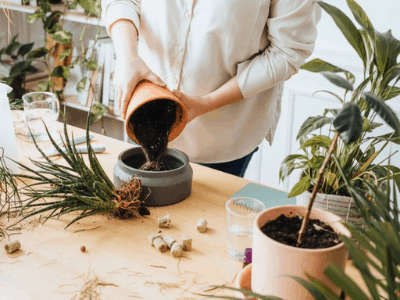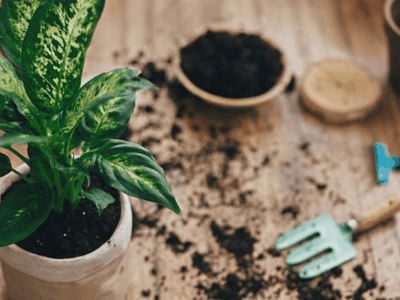
Should I Repot After I Bought New Plants?
Repotting a plant is an important process that can stimulate the growth of the plant.
But should you repot your indoor plants the moment you buy them? Let’s find out!
Indoor plants should not be repotted immediately after their arrival home.
This is because plants are affected…
…by changes in light, watering, temperature, and humidity.
Repotting them at this stage may cause further stress, leading to wilting.
Sometimes it is difficult for beginners to decide whether..
…to repot the houseplants they buy after they purchase them.
Throughout this article, we’ll discuss different scenarios in which indoor plants should be repotted…
…and when they shouldn’t. The discussion below will also cover the pros and cons one may encounter
while doing so...
If you need some information about gardening itself especially
…for Jade Plant and Snake Plant, you can go to our site!
But before that here we have a story about Mark having an experience repotting plant after he buy it!
Let us hear Mark’s stories!
I could tell that it was time to repot the plants in the backyard.
I knew this because they were starting to get too big for their containers,
…and many of them had grown wild.
When I took a look around, I found that some of my favorite plants…
...had really grown so tall-even taller than me!
It might have been nice if they grew more slowly,
…but as any plant owner knows, that’s just not how things work.
So it was time to do something about it before we end up with an overgrown jungle out here…
…and reducing the risk for over-growing plants in a small pot.

You probably don’t want to repot a plant right after you get it. If you just got a new plant that’s still in the container it came in, the experts agree you should give it a few days or even weeks to acclimate to your home before transferring it to a different planter.”
Danielle Gonzalez, author from huffpost.com
Here’s the main thing!
Is Repotting Plants Really Necessary?

While there are several reasons to avoid repotting your indoor plants…
…after buying them, there are times…
…when repotting them becomes necessary.
Consider these situations when you should repot them:
- It is often the case that sellers use smaller pots for their plants in order to save money. Smaller pots often lead to a root-bound situation, which negatively affects the growth of the plant. To prevent that, repot your newly purchased plant in a larger pot.
- Often, plant producers use chemical fertilizers or hormones as steroids in order to make their crops look good and flourish, and then sell them to nurseries or other planters. Plants without these hormones will not thrive, and thus new soil mixtures are required.
- When the soil is submerged in the pot, it indicates that the plant does not have enough soil, and if the tops of the leaves are brown or the leaves are dull, they are dry, and therefore they need to be replanted.
- If the roots are coming out of the pot or the drainage system is not working properly, you should repot.
- It is possible that the soil mix the plants are raised in contains additives, such as microscopic fungus. These fungi attach themselves to plant roots and need more water and nutrients than they normally would.
- You should always repot plants if you see salt buildup on the leaves, as you never know the actual condition of the soil. Repotting is the best way to make sure the plants remain healthy.
Keep reading…
Things To Keep In Mind Before Repotting

After you buy indoor plants, you need to repot them in the following ways:
- If the plant is experiencing problems (if there are any), isolate it while it takes time for the problems to manifest.
- The newly purchased plants will need some time to adjust to the new surroundings of your home since they are already in shock from moving from one environment to another.
- Before repotting, you should supply the plant with water the night before because it will give the plant time to adjust to its new environment and have some relaxation.
- Study your new plant and make sure it is growing in the right soil mix for its pot. Schedule the proper watering based on the pot and soil mix.
- When you have purchased your plants online, it is best to repot them as soon as possible. This is because they have already been travelling for several days before you received them. This is because it has to go through a restoration process as well as acclimatization, and most plants are transported in smaller pots, so repotting may be necessary.
The plants will arrive at your doorsteps in 2-3 days..
..so you need to provide them with a suitable environment to enable them to adapt quickly.
Tips for maintaining a healthy plant:
- Repot plants in the evening because the temperature is cooler. The plants will then have time to adjust to their new pot and avoid a shock situation.
- If possible, choose permeable pots and make sure they have proper drainage. Be sure to sanitize all tools they will use to repot the plant.
- Aerating the soil mixture is necessary if you are using a plastic pot, as plastic pots hold moisture.
- Use a proper soil mix for your plant, and avoid adding chemical fertilizers when repotting.
- Do not place the newly repotted plant in full sun or too much sunlight as it may cause the plant to suffer from sunburn. Instead, keep the plant in dim light until you see new growth.
After you know what’s the most suitable pot for your new plants, let’s talk about…
What To Prepare Before Repotting The Plant You Just Bought

There are several items to prepare so that the repotting process,
…could be done without leaving any mess that you would regret cleaning after.
Here are our repotting pro tools:
- Potting Tarp – is the fundamental tool you should have when repotting. It is the ultimate mess-free guaranteed item!
- Gloves – don’t get germs into your hands by simply using gardening gloves.
- Gardening Shovel – you’ll need this to move new soil mix!
- Succulent Soil Mix/ Regular Soil Mix – pay attention to your plant’s needs!
- Natural Fertilizer – this kind of fertilizer is always favourable to the greens!
- Pot with drainage – better preventing your plants from root rot, right?
Now let’s get into the main topic!
How Do You Repot A Plant You Just Bought?

If you want to pot your newly purchased plant, you need to follow these steps:
Take Out The Plant
When removing plants from plastic or bags, cut the plastic or bag carefully.
If the plants have been shipped in pots...
…gently tap the pot on the outside and remove the plants.
Keep the soil moist so that the plants can easily come out of their pots.
Soak The Plant
Many of the plants become dehydrated during the transport process.
Dissolve soil from the root zone quickly by soaking it in a bucket of water.
This will avoid damaging the roots and will prevent them from drying out…
…while the plant is being repotted.
Please do not break the soil or force the plant out of the pot with your hands.
Choose A Pot
For your newly acquired houseplant,
…you should choose a container that is suitable for it.
A pot should always be about 2 inches larger than the current size.
Give your plant roots plenty of space…
….so they can support the whole plant. The pot should be porous
…or have an appropriate drainage system…
….otherwise, it is unimportant. Unglazed pots such as terracotta,
..ceramic, etc., may be used for better results.
During our research on repotting plants after buying, we find that plants tend to adapt faster using this terracotta pot
Prepare Your Pot
You can use a piece of clay that is not flat over the drainage hole
…and add some sand to the potting mix…
….ensuring the drainage hole is large enough for water to drain.
This will keep soil from coming out, but allow water to get to the roots.
You should soak the pot beforehand if you are using a terracotta pot….
…as they absorb moisture and dry out the plant.
Some types of soil might retain more water longer than the usual, for some plants that are sensitive towards water such as succulents and orchids, this soil mix is proven to help the roots to breathe.
- Created for those who love growing succulents as much as we do, Miracle-Gro Succulent Potting Mix contains the nutrients succulents need to thrive
- This succulent potting soil is fast-draining and features a blend of sphagnum peat moss, forest products and fertilizer
- Great for helping to grow happy and beautiful succulent varieties like Burro’s Tail, Echeverias, Houseleek, as well as cacti
- Certified by the Mulch & Soil Council as a quality product in compliance with industry standards
- A single 4-qt. bag fills an 8-inch container; for even more spectacular results, start regular feedings with Miracle-Gro plant food 30 days after plant
Plant In The Pot
This will help the soil to retain water and prevent spilling over the edge.
Now place the root ball so that it sits in the middle of the pot, 2 inches below the top of the pot.
Last but not least…
Add Soil
It is important to add soil mix to the plant.
Add soil mix around the plant until it is evenly distributed…
…and the plant is upright on its own.
The plant should be thoroughly watered and the excess water…
…should be drained completely from the bottom of the planter.
Tips: You can water your newly repotted plant with a teaspoon of Epsom salt in a litre of water.
This will promote your plant’s growth and allow it to recover from the shock of repotting easily.
Sum Up
We can conclude that repotting the indoor plant after…
…purchase is only possible after analyzing…
…the current state of the plant. In certain circumstances,
…repotting your plants might do more harm than good.
In others, however, you may need to do it.
The best way to decide whether to repot your plants…
…would be to evaluate the situation first.
If needed, you can always keep the plants in the same pot.
Conclusion
Last thing for sure. This plant needs to care for carefully,
…remember all plants need “love” too.
Alright, that’s all for today! Do you have any questions about all of this?
Or do you want to add some method that can help you for repotting your plant?
Let me know your recommendation from the comment below.
Check out more of our posts like this one here!
I hope you can now take care your plant and it’s growing big and healthy!
Thanks for reading this article! Bye!



